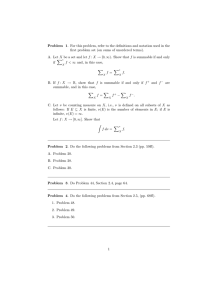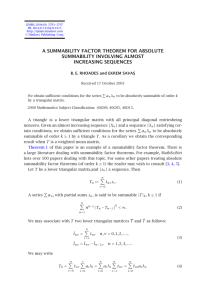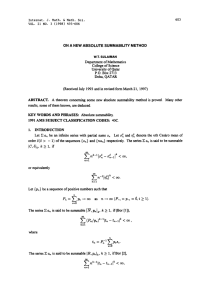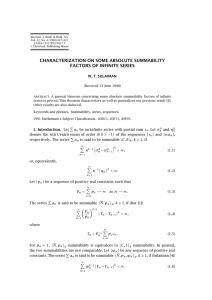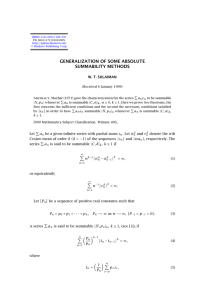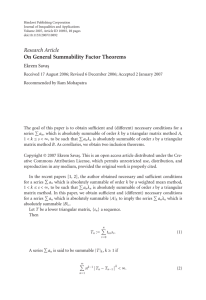ON INCLUSION RELATIONS FOR ABSOLUTE SUMMABILITY S
advertisement
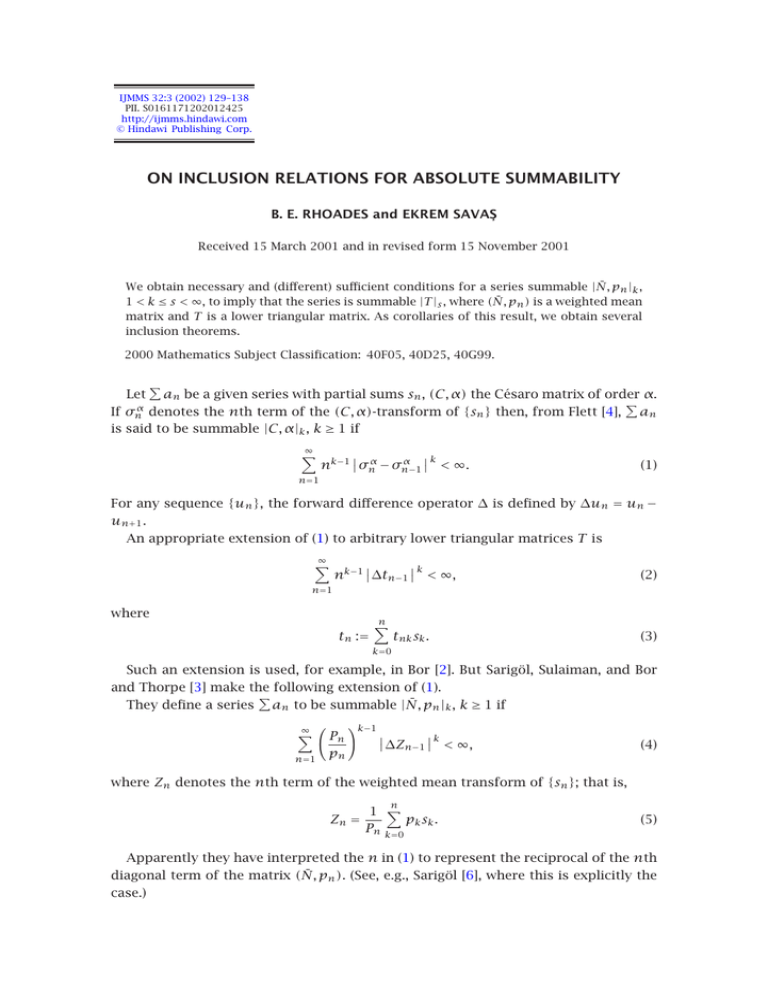
IJMMS 32:3 (2002) 129–138
PII. S0161171202012425
http://ijmms.hindawi.com
© Hindawi Publishing Corp.
ON INCLUSION RELATIONS FOR ABSOLUTE SUMMABILITY
B. E. RHOADES and EKREM SAVAŞ
Received 15 March 2001 and in revised form 15 November 2001
We obtain necessary and (different) sufficient conditions for a series summable |N̄, pn |k ,
1 < k ≤ s < ∞, to imply that the series is summable |T |s , where (N̄, pn ) is a weighted mean
matrix and T is a lower triangular matrix. As corollaries of this result, we obtain several
inclusion theorems.
2000 Mathematics Subject Classification: 40F05, 40D25, 40G99.
Let an be a given series with partial sums sn , (C, α) the Césaro matrix of order α.
If σnα denotes the nth term of the (C, α)-transform of {sn } then, from Flett [4], an
is said to be summable |C, α|k , k ≥ 1 if
∞
n=1
α k
nk−1 σnα − σn−1
< ∞.
(1)
For any sequence {un }, the forward difference operator ∆ is defined by ∆un = un −
un+1 .
An appropriate extension of (1) to arbitrary lower triangular matrices T is
∞
k
nk−1 ∆tn−1 < ∞,
(2)
n=1
where
tn :=
n
tnk sk .
(3)
k=0
Such an extension is used, for example, in Bor [2]. But Sarigöl, Sulaiman, and Bor
and Thorpe [3] make the following extension of (1).
They define a series an to be summable |N̄, pn |k , k ≥ 1 if
∞
n=1
Pn
pn
k−1
∆Zn−1 k < ∞,
(4)
where Zn denotes the nth term of the weighted mean transform of {sn }; that is,
Zn =
n
1 pk s k .
Pn k=0
(5)
Apparently they have interpreted the n in (1) to represent the reciprocal of the nth
diagonal term of the matrix (N̄, pn ). (See, e.g., Sarigöl [6], where this is explicitly the
case.)
130
B. E. RHOADES AND E. SAVAŞ
Unfortunately, this interpretation cannot be correct. For if it were, then, since the
nth diagonal entry of (C, α) is O(n−α ), (1) would take the form
∞
α (k−1) α
σ − σ α k < ∞.
n
n
n−1
(6)
n=1
However, Flett stays with (1). Thus (2) is an appropriate extension of (1) to lower
triangular matrices.
Given any lower triangular matrix T , we can associate the matrices T̄ and T̂ with
entries defined by
n
t̄nk =
tni , t̂nk = t̄nk − t̄n−1,k ,
(7)
i=k
respectively.
Thus, from (3),
tn =
n
k=0
n
tnk sk =
tnk
k=0
Yn := tn − tn−1 =
n
k
ai =
i=0
t̄ni ai −
i=0
n
ai
i=0
n−1
n
tnk =
k=i
t̄nk ai ,
i=0
t̄n−1,i ai =
i=0
n
n
(8)
t̂ni ai ,
since t̄n−1,n = 0.
i=0
For a weighted mean matrix A = (N̄, pn ),
ānk =
n
1 pk
Pk−1
=
.
Pn − Pk−1 = 1 −
P
P
Pn
n
n
i=k
Thus
ânk = ānk − ān−1,k = 1 −
(9)
Pk−1
Pk−1
pn Pk−1
−1+
=
,
Pn
Pn−1
Pn Pn−1
(10)
so that, from (5),
Xn := ∆Zn−1 =
n−1
n−1
pn
pn
Pk−1 ak =
Pν−1 aν ,
Pn Pn−1 k=0
Pn Pn−1 ν=1
(11)
since P−1 = 0.
We will always assume that {pn } is a positive sequence with Pn → ∞. Also, ∆ν t̂nν :=
t̂nν − t̂n,ν+1 .
Theorem 1. Let 1 < k ≤ s < ∞, {pn } satisfying
∞
n=ν+1
nk−1
pn
Pn Pn−1
k
=O
1
Pνk
.
Let T be a lower triangular matrix. Then, the necessary conditions for
|N̄, pn |k to imply an is summable |T |s are
(i) Pν |tνν |/pν = O(ν 1/s−1/k );
∞
ns−1 |∆ν t̂nν |s = O(ν s−s/k (pν /Pν )s );
(ii)
n=ν+1
∞
s−1
|t̂n,ν+1 |s = O(1).
(iii)
n=ν+1 n
(12)
an summable
ON INCLUSION RELATIONS FOR ABSOLUTE SUMMABILITY
131
Proof. We are given that
∞
s
ns−1 Yn < ∞,
(13)
k
nk−1 Xn < ∞.
(14)
n=1
whenever
∞
n=1
Now, the space of sequences {an } satisfying (14) is a Banach space if normed by
1/k
∞
k k
X = X0 +
nk−1 Xn .
(15)
n=1
We also consider the space of those sequences {Yn } that satisfy (13). This is also a
BK-space with respect to the norm
1/s
∞
s
k ns−1 Yn .
Y = Y0 +
(16)
n=1
Observe that (8) transforms the space of sequences satisfying (14) into the space
of sequences satisfying (13). Applying the Banach-Steinhaus theorem, there exists a
constant K > 0 such that
Y ≤ KX.
(17)
Applying (11) and (8) to aν = eν − eν+1 , where eν is the νth coordinate vector, we
have, respectively,
0,
pν
Xn = Pν ,
pν pn
,
−
Pn Pn−1
0,
if
Yn = t̂nν ,
if
∆ t̂ , if
ν nν
if n < ν,
if n = ν,
if n > ν,
(18)
n < ν,
n = ν,
n > ν.
By (15) and (16), it follows that
X = ν k−1
Y = ν
pν
Pν
s−1 k
+
∞
nk−1
n=ν+1
k 1/k
∞
s
s
ns−1 ∆ν t̂nν tνν +
n=ν+1
recalling that t̂νν = t̄νν = tνν .
pν pn
Pn Pn−1
,
(19)
1/s
,
(20)
132
B. E. RHOADES AND E. SAVAŞ
Using (19) and (20) in (17), along with (12), it follows that
k
k s/k
∞
∞
p
p
p
s
s
ν
ν n
ns−1 ∆t̂nν ≤ K s ν k−1
+
nk−1
ν s−1 tνν +
P
P
P
ν
n n−1
n=ν+1
n=ν+1
≤ K s ν k−1
=O
pν
Pν
pν
Pν
k
k
pν
+ O(1)
Pν
k
s/k
(21)
s/k
ν
k−1
.
The above inequality will be true if and only if each term on the left-hand side is
O((pν /Pν )k ν k−1 )s/k .
Taking the first term,
s/k
k
pν
s
ν k−1 ,
ν s−1 tνν = O
Pν
s
s
p
ν
tνν = O
ν 1−s/k ,
Pν
1/s
s
p
ν
tνν = O
ν 1−s/k
Pν
pν
1/s−1/k
=O
ν
,
Pν
(22)
which verifies that (i) is necessary.
Using the second term, we have
s/k
k
s
pν
pν
s
ns−1 ∆t̂nν = O
ν k−1 = O
ν s−s/k ,
P
P
ν
ν
n=ν+1
∞
(23)
which is condition (ii).
If we now apply (11) and (8) to aν = eν+1 , we have, respectively,
Xn =
0,
if n ≤ ν,
P ν pn
, if n > ν,
Pn Pn−1
0,
if n ≤ ν,
Yn =
t̂
, if n > ν.
n,ν+1
(24)
ON INCLUSION RELATIONS FOR ABSOLUTE SUMMABILITY
133
The corresponding norms are
k 1/k
∞
Pν p n
nk−1
,
X =
Pn Pn−1
n=ν+1
1/s
∞
s
Y =
ns−1 t̂n,ν+1 .
(25)
n=ν+1
Applying (17) and (12),
k s/k
∞
Pν pn
s
ns−1 t̂n,ν+1 ≤ K s
nk−1
,
Pn Pn−1
n=ν+1
n=ν+1
∞
(26)
which is condition (iii).
Corollary 2. Let T be a lower triangular matrix, {pn } satisfying (12). Then the
necessary conditions for an summable |N̄, pn |k to imply an summable |T |k are
(i) Pν |tνν |/pν = O(1);
∞
nk−1 |∆ν t̂nν |k = O(ν k−1 (pν /Pν )k );
(ii)
n=ν+1
∞
k−1
|t̂n,ν+1 |k = O(1).
(iii)
n=ν+1 n
To prove Corollary 2, simply set s = k in Theorem 1.
A lower triangular matrix T is called a triangle if each tnn ≠ 0.
Theorem 3. Let 1 < k ≤ s < ∞. Let T be a triangle with bounded entries such that
T and {pn } satisfy the following:
(i) tνν = O((pν /Pν )ν 1/s−1/k );
(ii) (n|Xn |)s−k = O(1);
n−1
|∆ν t̂nν | = O(|tnn |);
(iii)
ν=1
∞
(iv)
(n|tnn |)s−1 |∆ν t̂nν | = O(ν s−1 |tνν |s );
n=ν+1
n−1
|tνν ||t̂n,ν+1 | = O(|tnn |);
(v)
ν=1
∞
s−1
|t̂n,ν+1 | = O(ν|tνν |)s−1 .
(vi)
n=ν+1 (n|tnn |)
Then an is N̄, pn |k .
Proof. Solving (11) for {an } and substituting into (8) give
Yn =
n
t̂nν
ν=1
=
n
n
ν=1
=
n
t̂nν
Xν Pν Xν−1 Pν−2
t̂nν
−
pν
pν−1
ν=1
t̂nν
n−1
Xν Pν Xν Pν−1
t̂n,ν+1
−
pν
pν
ν=0
ν=1
=
Xν Pν Xν−1 Pν−2
−
pν
pν−1
n−1
Xν
t̂nn Xn Pn t̂nν Pν − t̂n,ν+1 Pν−1
+
pn
pν
ν=1
134
B. E. RHOADES AND E. SAVAŞ
n−1
Xν
tnn Pn Xn +
Pν t̂nν − t̂n,ν+1 + t̂n,ν+1 Pν − Pν−1
pn
pν
ν=1
n−1
Pn tnn Xn Pν
=
+
∆ν t̂nν + t̂n,ν+1 Xν
pn
pν
ν=1
=
= Tn1 + Tn2 + Tn3 .
(27)
From Minkowski’s inequality, it is sufficient to show that
∞
s
ns−1 Tni < ∞,
i = 1, 2, 3.
(28)
n=1
Using condition (i) of Theorem 3,
J1 :=
∞
s−1 n
n=1
s
∞
s
s−1 tnn Pn
Tn1 =
n Xn pn
n=1
= O(1)
∞
s s
ns−1 n1/s−1/k Xn (29)
n=1
= O(1)
∞
k s−k nk−1 Xn ns−s/k−k+1 Xn .
n=1
But
s−k 1−1/k s−k
s−k
Xn ns−s/k−k+1 Xn = O(1),
= n
= O nXn from (ii) of Theorem 3.
Since an is summable, |N̄, pn |k , J1 = O(1).
Using Hölder’s inequality and conditions (i), (ii), (iii), and (iv) of Theorem 3.
n−1 s
∞
P s
ν
ns−1 Tn2 =
ns−1 ∆ν t̂nν Xν p
ν
n=1
n=1
ν=1
n−1
s
∞
−1 = O(1)
ns−1
ν 1/s−1/k tνν ∆ν t̂nν Xν J2 :=
∞
n=1
= O(1)
∞
n=1
ν=1
ns−1
n−1
n−1
s−1
−s s
∆ν t̂nν ν 1−s/k tνν ∆ν t̂nν Xν ×
ν=1
ν=1
∞
s−1 n−1
−s s
ntnn = O(1)
ν 1−s/k tνν ∆ν t̂nν Xν n=1
= O(1)
∞
ν=1
ν=1
∞
−s s s−1 ∆ν t̂nν ν 1−s/k tνν Xν ntnn n=ν+1
(30)
ON INCLUSION RELATIONS FOR ABSOLUTE SUMMABILITY
= O(1)
= O(1)
∞
135
−s s
s
ν 1−s/k tνν Xν ν s−1 tνν ν=1
∞
s
ν s−s/k Xν ν=1
= O(1)
= O(1)
∞
ν=1
∞
k s−k ν k−1 Xν ν s−s/k−k+1 Xν k
ν k−1 Xν = O(1).
ν=1
(31)
By Hölder’s inequality and conditions (v), (vi), and (iii) of Theorem 3, we have
n−1
s
∞
s
t̂n,ν+1 Xν ns−1 Tn3 =
ns−1 n=1
n=1
ν=1
n−1
s
∞
t̂n,ν+1 Xν ≤
ns−1
J3 :=
∞
n=1
≤
∞
ν=1
n−1
1−s s
s−1
n
tνν
t̂n,ν+1 Xν
n=1
ν=1
n−1
s−1
×
tνν t̂n,ν+1
ν=1
= O(1)
∞
1−s s−1 n−1
tνν t̂n,ν+1 Xν s
ntnn n=1
ν=1
∞
∞
1−s s s−1 tνν Xν t̂n,ν+1 = O(1)
ntnn ν=1
(32)
n=ν+1
∞
1−s s s−1
tνν Xν ν tνν = O(1)
= O(1)
= O(1)
= O(1)
ν=1
∞
ν=1
∞
ν=1
∞
s
ν s−1 Xν k s−k
ν k−1 Xν ν Xν k
ν k−1 Xν = O(1).
ν=1
Corollary 4 (see [5]). Let T be a nonnegative lower triangular matrix, {pn } a
positive sequence satisfying
(i) tni ≥ tn+1,i , n ≥ i, i = 0, 1, 2, . . .;
(ii) Pn tnn = O(pn );
(iii) t̄n0 = t̄n−1,0 , n = 1, 2, . . .;
136
B. E. RHOADES AND E. SAVAŞ
n−1
(iv)
|tii ||t̂n,i+1 | = O(tnn );
i=1
∞
k
k−1
|∆i t̂ni | = O(ik−1 tii
);
(v)
n=i+1 (ntnn )
∞
k−1
(vi)
|t̂n,i+1 | = O((itii )k−1 ).
n=i+1 (ntnn )
Then an summable |N̄, pn |k implies an summable |T |k , k ≥ 1.
Proof. Since s = k and T is nonnegative, condition (ii) of Theorem 3 is automatically satisfied, and conditions (ii), (iv), (v), and (vi) of Corollary 4 are equivalent to
conditions (i), (v), (iv), and (vi) of Theorem 3, respectively
∆ν t̂nν = t̂nν − t̂n,ν+1 = t̄nν − t̄n−1,ν − t̄n,ν+1 + t̄n−1,ν+1 = tnν − tn−1,ν .
(33)
Therefore, using conditions (i) and (iii) of Corollary 4,
n−1
ν=1
n−1
∆ν t̂nν =
tn−1,ν − tnν = 1 − tn−1,0 − 1 + tnn + tn0 ≤ tnn ,
(34)
ν=1
and condition (iii) of Theorem 3 is satisfied.
Remark 5. For 1 < k ≤ s < ∞, necessary and sufficient conditions for a triangle
A : k → s are known only for factorable matrices (see Bennett [1]), which include
weighted mean matrices. Therefore, we should not expect to obtain a set of necessary
and sufficient conditions when an arbitrary triangle is involved.
However, necessary and sufficient conditions for a matrix A : → s , 1 ≤ s < ∞ are
known. The following result comes from Theorem 2.1 of Rhoades and Savaş [5] by
setting each λn = 1.
Theorem 6. Let T be a lower triangular matrix. Then
an summable |N̄, pn |k
implies an summable |T |s , s ≥ 1 if and only if
(i) Pν |tνν |/pν = O(ν 1/s−1 ),
∞
ns−1 |∆ν t̂nν |s = O((pν /Pν )s ),
(ii)
n=ν+1
∞
s−1
|t̂n,ν+1 |s = O(1).
(iii)
n=ν+1 n
Remark 7. In [5], it is assumed that T has nonnegative entries and row sums one,
but these restrictions are not used in the proofs.
Finally, we state necessary and sufficient conditions when k = s = 1.
Theorem 8. The series an summable |N̄, pn | implies an summable T if and
only if
(i) Pν |tνν |/pν = O(1);
∞
|∆ν t̂nν | = O(pν /Pν );
(ii)
n=ν+1
∞
(iii)
n=ν+1 |t̂n,ν+1 | = O(1).
Proof. Note that, with k = 1, (12) is automatically satisfied. Therefore, the necessity of the conditions follows from Theorem 1.
To prove the conditions sufficient, use [5, Corollary 4.1] by setting each λn = 1.
Corollary 9.
an summable |C, 1| implies an |N̄, qn | if and only if
(i) nqn /Qn = O(1).
137
ON INCLUSION RELATIONS FOR ABSOLUTE SUMMABILITY
Proof. With each pn = 1, T = (N̄, qn ), condition (i) of Theorem 8 reduces to condition (i) of Corollary 9.
Using (33),
∞
∞
∞
p
pν ν
∆ν t̂nν =
tnν − tn−1,ν =
−
Pn Pn−1 n=ν+1
n=ν+1
n=ν+1
∞
pν
pn
=
,
= pν
P
P
Pν
n
n−1
n=ν+1
(35)
and condition (ii) of Theorem 8 is satisfied. Since (N̄, pn ) has row sums one,
t̂n,ν+1 = t̄n,ν+1 − t̄n−1,ν+1 =
n
i=ν+1
= 1−
ν
tni − 1 +
i=0
ν
(36)
pn
= 1,
P
P
n=ν+1 n n−1
(37)
ν
ν
tn−1,i − tni =
=
i=0
=
pn
Pn Pn−1
tn−1,i
i=ν+1
tn−1,i
i=0
i=0
ν
n
tni −
pi
pi
−
Pn−1 Pn
pn Pν
.
Pn Pn−1
pi =
i=0
Therefore
∞
∞
t̂n,ν+1 = Pν
n=ν+1
and condition (iii) of Theorem 8 is satisfied.
Corollary 10. The series an summable |N̄, pn |k implies an summable |C, 1|k
if and only if
(i) Pn /(npn ) = O(1).
Proof. Using T = (C, 1) in Theorem 8, condition (i) of Theorem 8 reduces to condition (i) of Corollary 10.
From (33) and (i) of Corollary 10,
∞
∞
∞
∆ν t̂nν =
tn−1,ν − tnν =
n=ν+1
1
1
−
n
n
+
1
n=ν+1
n=ν+1
Pν
pν
1
ν
pν
=
=
=O
,
ν +1
νpν ν + 1
Pν
Pν
and condition (ii) of Theorem 8 is satisfied.
(38)
138
B. E. RHOADES AND E. SAVAŞ
Using (36),
ν
∞
∞
t̂n,ν+1 =
tn−1,i − tni n=ν+1
n=ν+1 i=0
∞
ν
1
1
−
=
n
n
+
1
n=ν+1 i=0
∞
1
1
1
−
(ν + 1) = (ν + 1)
= 1,
=
n n+1
ν +1
n=ν+1
(39)
and condition (iii) of Theorem 8 is satisfied.
Combining Corollaries 9 and 10, we have the following corollary.
Corollary 11. |N̄, pn | and |C, 1| are equivalent if and only if
(i) npn /Pn = O(1);
(ii) Pn /(npn ) = O(1).
Acknowledgment. The first author received partial support from the Scientific
and Technical Research Council of Turkey during the preparation of this paper.
References
[1]
[2]
[3]
[4]
[5]
[6]
G. Bennett, Some elementary inequalities, Quart. J. Math. Oxford Ser. (2) 38 (1987), no. 152,
401–425.
H. Bor, On the relative strength of two absolute summability methods, Proc. Amer. Math.
Soc. 113 (1991), no. 4, 1009–1012.
H. Bor and B. Thorpe, A note on two absolute summability methods, Analysis 12 (1992),
no. 1-2, 1–3.
T. M. Flett, On an extension of absolute summability and some theorems of Littlewood and
Paley, Proc. London Math. Soc. (3) 7 (1957), 113–141.
B. E. Rhoades and E. Savaş, A characterization of absolute summability factors, submitted
to Taiwanese J. Math.
M. A. Sarigöl, On local property of |A|k summability of factored Fourier series, J. Math. Anal.
Appl. 188 (1994), no. 1, 118–127.
B. E. Rhoades: Department of Mathematics, Indiana University, Bloomington, IN
47405-7106, USA
E-mail address: rhoades@indiana.edu
Ekrem Savaş: Department of Mathematics, Yüzüncü Yil University, Van, Turkey
E-mail address: ekremsavas@yahoo.com
